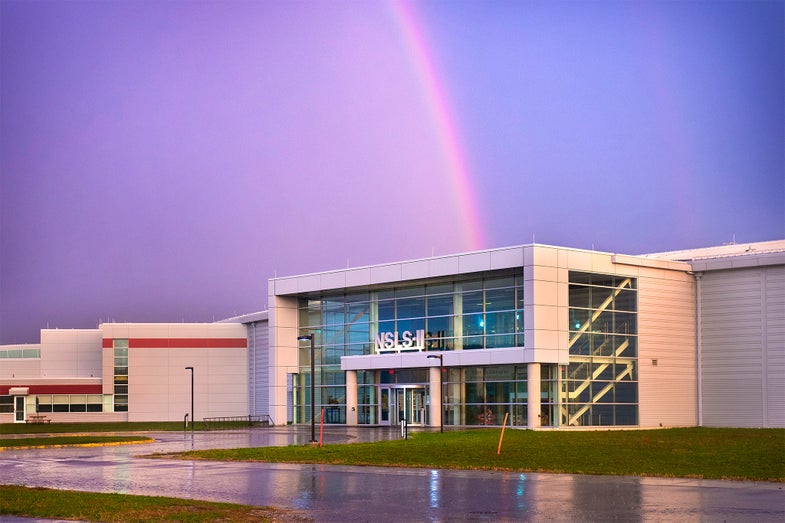3 Tech Futures A Particle Accelerator On Long Island Could Bring Us
Magic to expect from the world's brightest source of x-rays

Last week, we journeyed to Long Island, New York, to tour one of the most advanced particle accelerators in the world. The occasion: its official opening. The mission: to see what technological advancements it might soon beam into our everyday lives.
Inside the warehouse-like building holding the National Synchrotron Light Source II (NSLS-II), as the accelerator is called, political figures took to a stage. Secretary of Energy Ernest Moniz, New York Senator Chuck Schumer, and New York Congressman Lee Zeldin each said his piece to dedicate the facility while scientists, technicians, and other dignitaries looked on.
“This is the beginning of the next big thing,” Doon Gibbs, the director of Brookhaven National Laboratory (BNL) told the crowd.
“Big,” in this case, is an understatement. The NSLS-II is packed with 843 giant magnets arranged into a circle half a mile in circumference. Each magnet is placed to an accuracy of 30 microns, or thinner than a thin piece of aluminum foil, and together they bend electrons traveling near light-speed into a circular beam. Where the beam bends, x-rays bleed off–and NSLS-II makes x-rays 10 million times stronger than those found in a dental or medical office; even compared to the first National Synchrotron Light Source, located across the street (and now shuttered), the new machine’s x-rays are 10,000 times brighter.
Uses for such powerful x-rays are almost countless. As the x-rays (along with infrared and ultraviolet light) bleed off the main ring, scientists wait for them with instruments to peer at scientific samples and perform experiments. One beamline might study nanomaterials for a solar panel, another the structures of biological proteins.
Seven beamlines are now up-and-running at NSLS-II, but there’s space for up to 60 beamline workshops. Agreeing to release your findings to the public can earn you free “beam time,” as it’s called, but companies such as IBM, GE, and GM are willing to pay about $400 an hour in hopes of patenting their discoveries. Eventually, as many as 4,000 scientists a year could use the facility–and expectations are high. Here are a handful of things that NSLS-II might beam into your future.
Better Batteries
In the past, battery researchers fiddled with existing designs until they got a more efficient cell. “We said, well that one worked better, but we never knew why,” says Esther Takeuchi, director of the Integrated Center for Energy Storage at BNL. Batteries basically had to be destroyed in order to see what was happening inside. At NSLS-II, researchers can watch battery prototypes as they go through charge cycles–and see exactly what’s going on. The hope is that, by watching materials like batteries in operando (academic parlance for “while they’re working”), researchers can finally achieve what we’ve all been waiting for: a cell phone that will never die! (Ok, maybe that’s just on my wish list.) More likely, we’ll see battery tech emerge from NSLS-II that’s best-suited to store electricity generated at wind and solar farms, making those power sources more consistent and useful for energy grids.
More Amazing Materials
Speaking of the grid: Another way researchers plan to use NSLS-II is to study nanomaterials, including those that might improve energy distribution and generation. “Nanomaterials,” by the way, covers basically anything at the scale of a billionth of a meter. Engineering near the atomic level could lead scientists to develop materials that conduct electricity better than any wire in use today, can stop a speeding bullet, heal themselves, and maybe even help us see in the dark. With the powerful light from NSLS-II, researchers can take an incredibly close look at the materials and make adjustments on the, well, nanoscale.
Smarter Medicine
BNL’s first light source was built primarily for chemists, physicists, and engineers to examine man-made materials, rocks, and explore the physical world on tiny scales. But, as it turned out, about 40 percent of the annual research done at the lab’s first light source involved biology. Most of these researchers flocked to NSLS to decode the structure of proteins–because some pharmaceuticals work by binding to proteins in the body, the thinking goes, knowing their exact makeup could lead to more effective drugs. That kind of work will continue at NSLS-II, with pharmaceutical companies and medical researchers working toward new generations of drugs.
Click here to see our image-gallery tour of NSLS-II on its opening day.